Stage 1 Biology FINAL EXAM
1/59
Earn XP
Description and Tags
give me a 5 star review :)
Name | Mastery | Learn | Test | Matching | Spaced |
|---|
No study sessions yet.
60 Terms
diploid and haploid cells
somatic (body) cells are diploid (have full set of chromosomes - 22 autosmal pair and 1 pair sex cells)
homologous chromosome - 2 chromosomes that form a pair
sperm and ova (sex cells) are haploid - only one set of chromosomes from each homologuspair
formed through meiosis and only contain ½ bc they fuse during fertilisation and chromosome number doubles
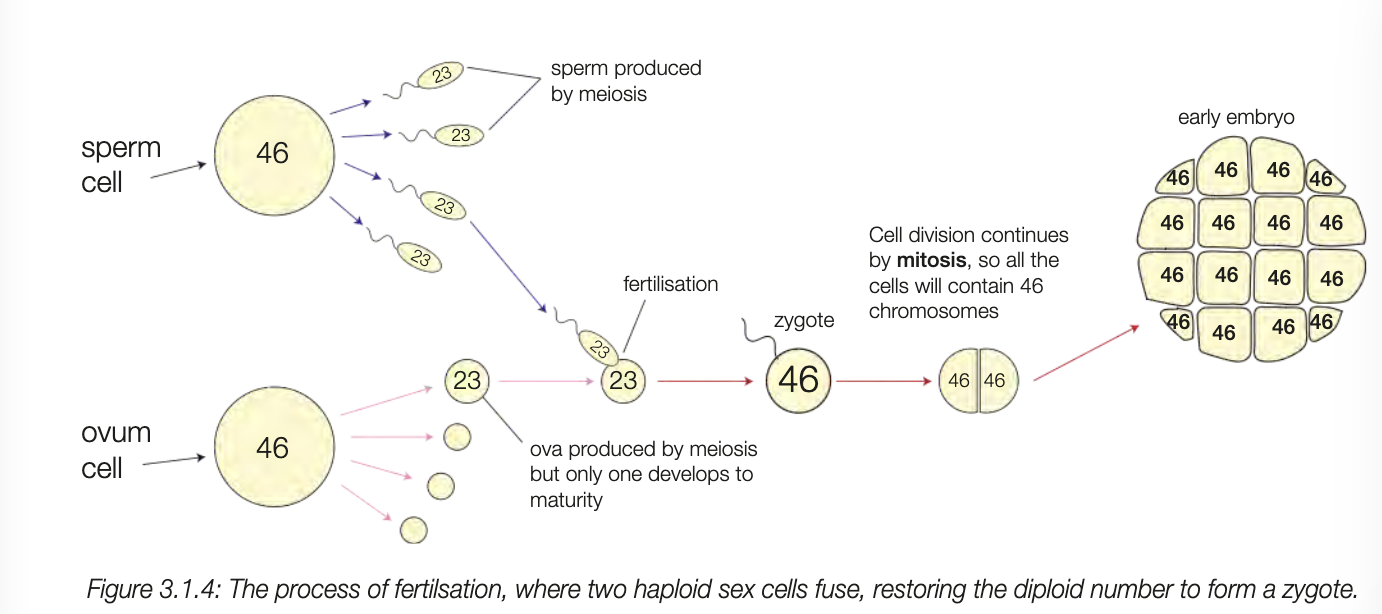
transcription
dna is in nucleus, ribsomes in cytoplasm, dna is too big to leave it
gene is copied by RNA polymerase into messenger RNA (mRNA) to deliver from nucleus to ribsome
mRNA produced through trasncription is copy of gene with the sequence of nucleotides for order og amino acids
RNA polymerase protein binds to DNA near gene coding for required protein
RNA polymerase unwinds double helix, exposing nucleotide base sequence of gene
RNA polymerase moves across exposed gene to synthesise mRNA molecule - working copy of gene taht can travel out of nucleus to be translated
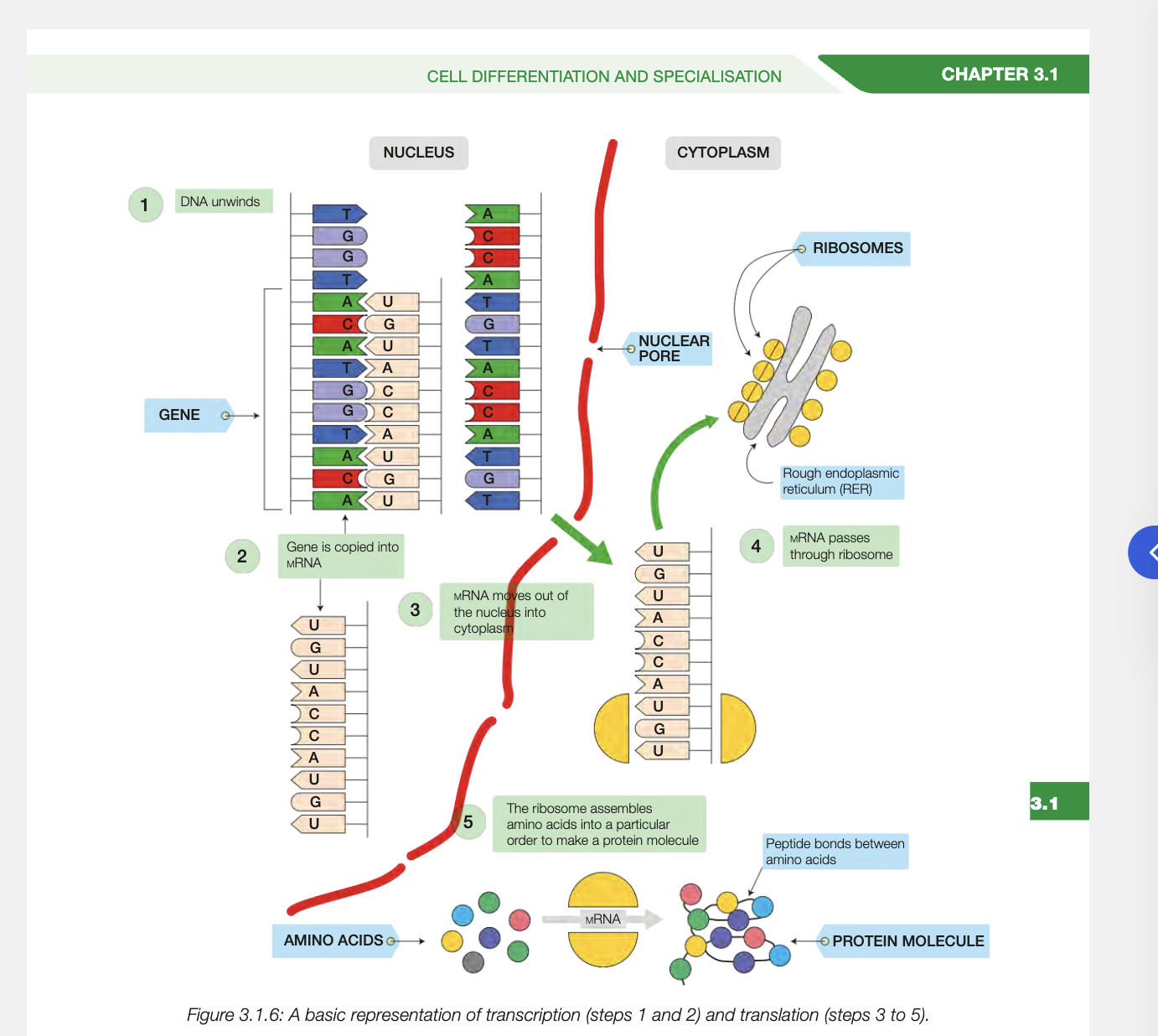
translation
amino acids are carried to ribosmoe during translation by tRNA (transfer RNA)
tRNA molecule can only carry one specific amino acid, only bond to 3 specific base section of mRNA its complementary to
ribsome moves acorss mRNA strand, tRNA carry specific amino acids into correct position in chain of amino acids
ribosome facillitates formation of strong peptide bonds between them and make polypeptide chain
polypeptide chain folds in precise way to make protein
shape of protein is based on order of amino acids, shape determines function
mRNA is trasported out of nucleus to ribsomes in cytoplasm
ribsomeomes move along mRNA strand and assemble amino acids in sepcific order with help of tRNA molecules fomring polypeptide
polypetide folds into precise 3D shape forming funcitonal protein
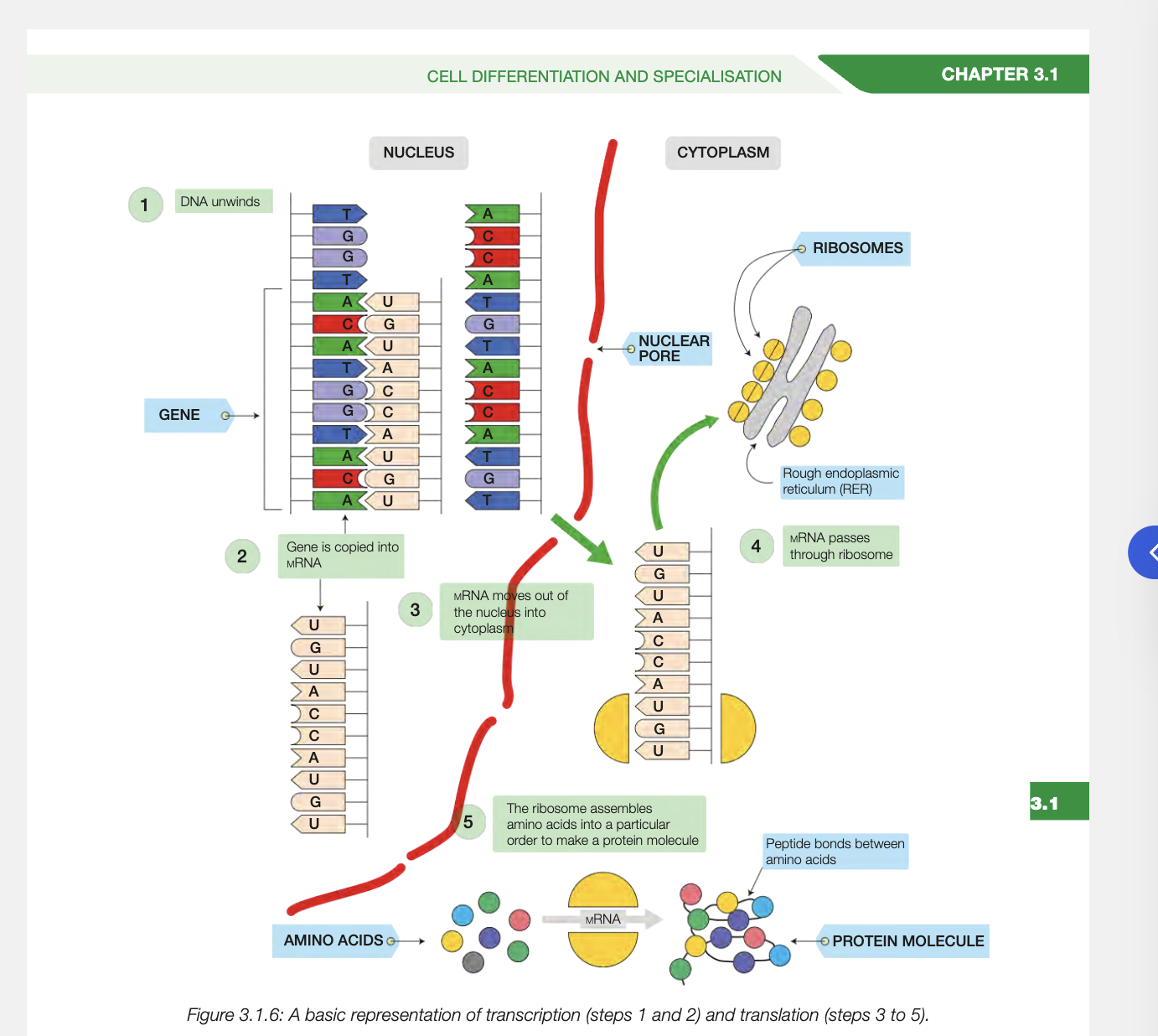
cell differentiation
zygote divides many times by mitosis and makes genticially identical embyonic stem cells (ball of it)
only some specific genes are switched on and produce specific proteins - gene expression - determines structure and function of specialisedd cells
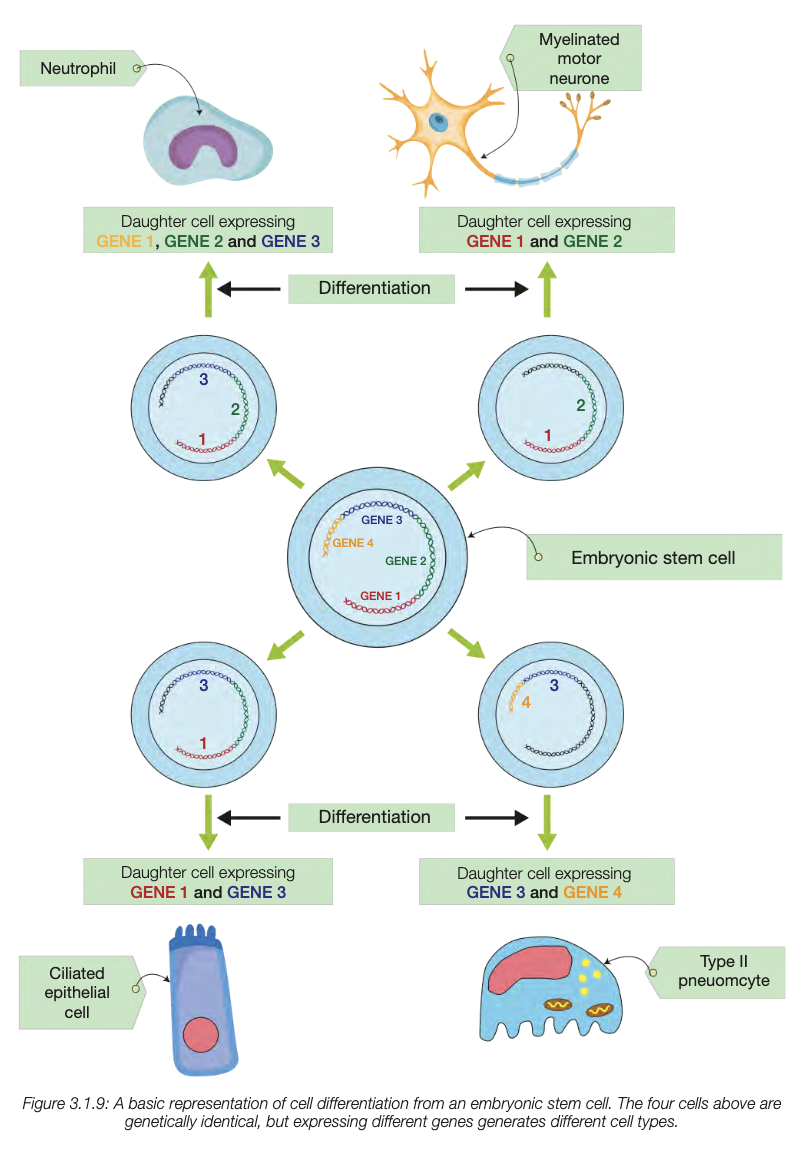
gene expression controlled - transcription factors
Transcription factors
proteins that affect binding of RNA polymerase to particular gene on DNA
each gene has short section of DNA called promoter region - located just before gene of DNA molecule
if RNA polymerase cna bind to promoter region of gene its swtiched on, transcription happens
if RNA polymerase cant find to genes promoter region its switched off
repressors can bind to promoter region and block RNA polymerase from transcribing gene
gene expression controlled - epigentic tags (how each affects gene expression)
epigenome - chemical tags DNA accumulates, additional level of coding on top of DNA base sequence
do not affect DNA base sequence but change how cells read DNA and express it
methylation of cytosine bases and acetylation of histones
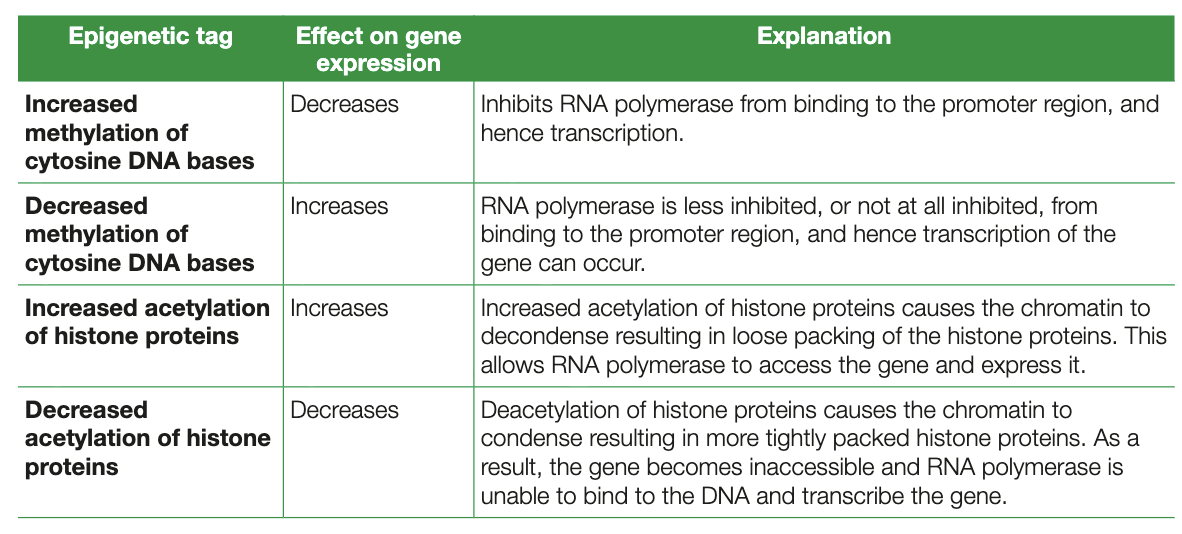
osteoporosis description, lifestyle contribution (risk and development)
DESCRIPTION - bones are weak and fragile due to reduced bone density. resul in curvature of spine, increased risk of fractures/breakages
DEVELOPMENT - sedentary lifetyle leads to poor bone density (weight bearing excericse neeeded for developemtn and maintenence of bones). low in calcium and vitamin D is bad, vitamin D needed to absorb calcium, needed for bone formatoin. lack of exposure to sun lowers vitamin D
REDUCE - regular weight bearing excercise, outside excercise allows body to synthesise vitamin D in sun. diet w dairy and dark leafy greens high in calcium
atherosclerosis description, lifestyle contribution (risk and development)
DESCRIPTION - build up of fatty deposits in arteries, fomring plaques. thickens arter walls, narrows channel reducing blod flow and ability to deliver nutrients to organ systems. full blockage results in heart attack or stroke
DEVELOPMENT - high saturated and trans fats diet increases cholestrol increasing risk of fatty deposits building up. low in fibre increases risk as fibre helps lower cholestrol
REDUCE - excercise increases production of good cholestrol levels, lowers bad ones in blood,decreases risk. reduces blood pressure. balanced diet high in plant based food, fatty fish (omega 3) and low in saturated trans fats
hypertension description, lifestyle contribution (risk and development)
DESCRIPTION - pressure in blood vessels is too high, can stiffen and injure walls of arteries, accelerating atherosclerosis. untreated leads to heart failiure
DEVELOPMENT - high in sodium diet increases risk - kidneys cant excrete sodium efficiently enough, water is retained by body to dilute sodium in blood, increasing blood volume and pressure. chronic stress increases blood pressure due to release of stress hormones activating pathways to increase heart rate and blood pressure
REDUCE - regualr physical activity reduces blood pressure, makes heart stronger, reduces stress. low sodium and simple sugar diet leads to less water retentino therefore lowered blood pressure
Definition
type 2 diabetes description, lifestyle contribution (risk and development)
DESCRIPTION - hormonal system has reduced ability to control blood glucose levels due to increased insulin resistance, attributed to poor diet/lifestyle choices
DEVELOPMENT - pancreatic cells rpdoucing insulin are reduced due to inflammation (from diet high in saturated fats), overstimulatoin of pancreatic cells to produce insulin (high in sugar diet) over a long time period (tire and die off)
REDUCE - exercise is energy intesnive, lowers blood glucose levels, burns fats (weight loss) reduces risk, increases insuling sensitivity - balanced diet low in simple sugars and saturated fats reduces risk of insulin resistance developing
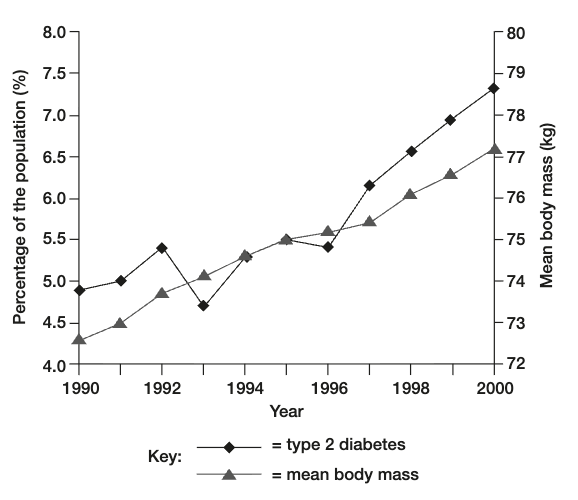
describe relationship between type 2 diabetes and average body mass
one limitation of investigation
how diet increases risk of developing type 2 diabetes
excercise level reduces risk of type 2 diabetes
From 1990 to 2000 the mean body mass of the population increased from 72.6 kg to 77.2kg. At the same time the percentage of the population with type 2 diabetes increased from 4.9% to 7.3%.
data is outdated (only up to 2000 not 2025), doesnt factor in cause of weight gain for all individuals within population
high in sugar overworks insulin producing pancreas, causes death of insulin producing cells in canreas, results in reduced ability to produce insulin in response to blood glucose
intense excecise leads to intense energy, lowers blood glucose levels burns fat, weight loss and reduced risk of t2 diabetes, increases insulin sensitivity
efficient exchange surface criteria
thin - reduces distance materials need to move during exchange
moist - allow substances ot dissolve in water, assit in trasnport across exchange surface
large total SA - provides more surface for exchange to happen
rich blood supply - trasnport substances to and from exchange surfaces, maintains concentration gradeitn
ventilation
2 PROCESSES - INSPIRATION AND EXPIRATION
air enters respiratory tract thru mouth or nose, passes through nasal cavity and is smelt, warmed, filtered, moistened. passes through pharynx, larynx, reaches bronchi. after gas exhchange, expanded lungs deflate, air forced back up repiratory tract to mouth/nose to be expelled
movement of air is achieved by generating changes of pressure in chest cavity - intercostal muscles ribs and diaphragm involved
in inhalation diaphragm contracts, flattens, intercostal muscles contract elevating ribcage up and out, making more space for lugns to expand into
increases volume of chest cavity, lowers air pressure inside lugns compared to outside body
in exhalation diaphragm relaxes and returns to resting dome shape and intercostal muscles relax, depressing ribs downwards and inwards
decreases volume of chest cavity, increases air pressure inside lungs compared in the outside body, expelling air from the lungs
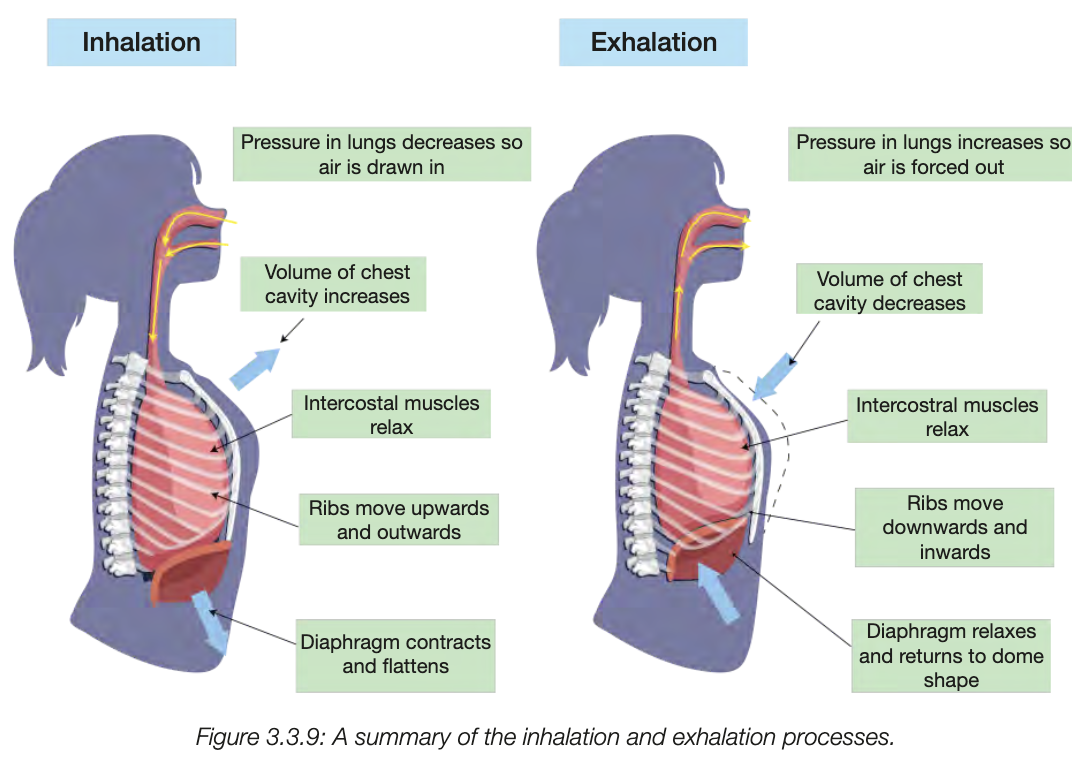
gas exchange in alveoli
occurs between alveoli and capillaries
capillaries have high co2 conc, low o2, air has high o2 low co2, causes o2 to diffuse from alveoli to capillaries down conc gradient (opposite direaction for co2)
facillitated by:
otal surface are of alveoli within lungs is extremely high because there are millions of alveoli
outside surface of alveoli are covered with lots of capillaries
distance of diffusion is very short because alveoli surface and capillary walls consist of single layer of epithelial tissue making them very thin
exchange of gases across alveoli assisted by presence of film of moisture covering inside surface of them - allows gases to dissolve in moisture and diffuse across

plasma and blood vessels
fluid component of blood cells
includes nutrients from digestion needed for cells for energy and growth, hromones transported to cells, salts maintaining osmotic pressure important for muslc econtraction, CO2 - metabolc waste, urea metabolic waste, antibodies for disease
arteries
blood vessels that take blood away from heart - carry oxygenated blood EXCEPT FOR PULMONARY ARTERY carries deoxygenated blood away from heart into lungs
blood in arteries transported through narrow central core under high pressure - big wall little lumen
have thick layer of smooth muscle and elastic fibres to cope w pressure\branch into arterioles, smaller and lead to capillaries
each heartbeat makes surge of blood enter arteries, expand to cope with increased blood flow
expansion and recoil is pulse
contraction and relaxation of smooth muscles within arteries is controlled by central nercous system - allows body to adjust flow of blood within body when needed
veins
venules (very small veins) extend form capillary beds, intersect to form veins
blood vessels that take blood back into heart - carry deoxygenated blood EXCEPT FOR PULMONARY VEIN carries oxygenated blood back into heart from lungs
conssit of thin layer of smooth muscle and elastic fibres
wide central tube - only blood vessel with valves - open in one direction to prevent backflow of blood
blood pressure in veins is lower than arteris and flow of blood is flower - greater distance from heart and wide central tubes
movement of blood can be facillitated by contractinos of adjacent skeletal muscles
muscles contracting and expanding supplies pressure on adjacent veins, adding pressure for blood flow througb one directional valves and back towards right of heart
capillaries
onnect arteries with veins (arterioles w venules)
only blood vessels where substances can be exhanged between blood and bodys cells
consist of single layer of epithelial cells, cnetral core is very narrow, ensureing red blood cells flow through in single file so theres less distance for gas exchange between red blood cells adn body cells
oxygenated blood enteres containing high O2 and useful substance conentration, low CO2 - useful is diffused with concentration gradients across capillary wall into surrounding tissue fluid
waste products diffuse with concentration gradients form body cells and tissue fluids into blood
blood leaving capillaries is deoxygenated blood
human circulatory system
4 chambered heart and double circulations - pulmonary and systemic
right side of heart pumps deoxygenated blood to lungs, blood is oxygenated and returned to left of heart - pulmonary ciculatoin
left side pumps oxygenated blood to rest of body to supply cells with oxygen and nutrients. blood becomes deoxygenated in process, metabolic wate diffuses into it
deoxygenated blood is moved back to right of heart, completeing systemic ciruclation
double circulation - blood travels through ehart 2 times to comeplte one full circulation of body
blood travelling thru lungs looses lots of blood pressure along capillaires, speed it travels slows
blood travels back to left side of heart so oxygenated blood can be pumped at high pressure so body cells receive blood supply quickly and frequently
main advantage of a double circulatory system is the efficient and complete separation of oxygenated and deoxygenated blood, which allows for higher blood pressure in the systemic circulation (to the body). This higher pressure leads to more efficient and faster delivery of oxygen and nutrients to the body's tissues and organs, supporting the high metabolic needs of active animals like mammals.
human heart (pulmonary and systemic circulation, structure)
located in thorax between lungs
cardiac muscle suplied with oxy blood by coronary arteries, deoxy leave by coronary veins
divided into 4 chambers - L and R seperated by septum
blood enters heart via atria (upper), pumped out by muscly walls of ventricles (lower)
L ventricle thicker because it pumps blood at higher pressure
R ventrickle thinner ebcause pumps deoxygenated shorter distance
4 valves prevent backflow
atrioventricular between atria and ventribles,
semilunar seperatibng RV from pulmonary artery, other from LV and aorta
connected to inner walls of heart by tendons
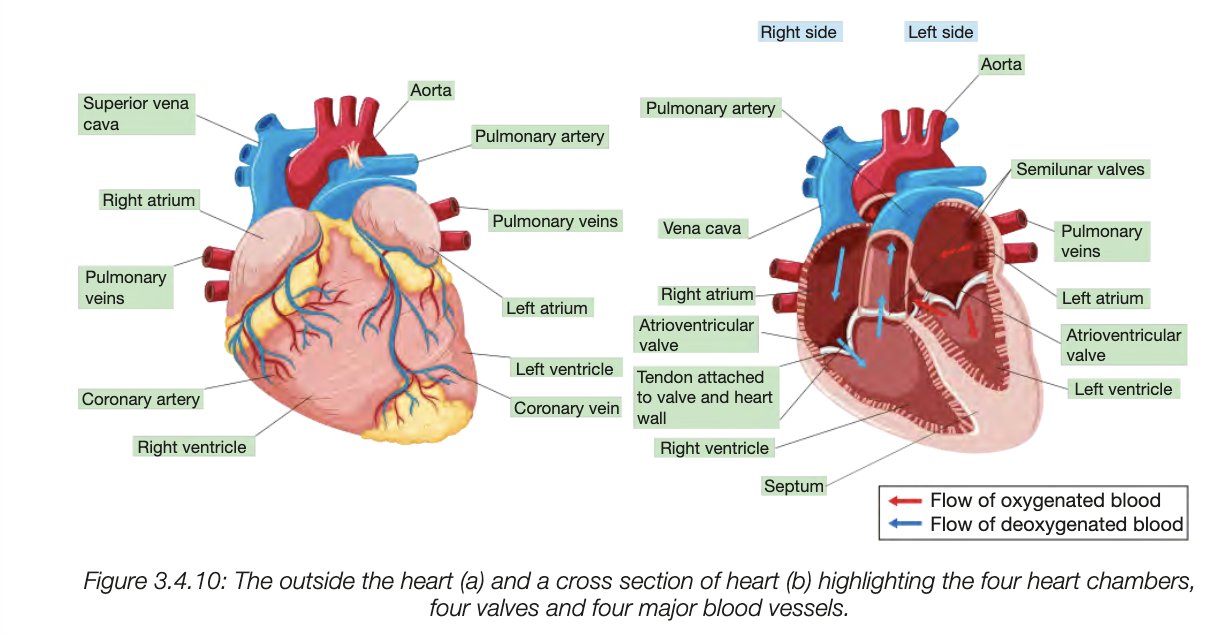
cardiac cycle
heart relaced - blood flows to atria
atriac contract, force blood to ventricles
ventricles contract - blood pressure inside rises, increased pressure closes atrioventricular valves (LUBB sound, prevent backflow)
rising pressure pushes open semilunar valve openm blood slows into arteries
finished contractoin makes pressure fall, semilunar close (DUBB SOUNDS)

movement of blood thru heart
deoxygenated blood from around the body enter the right ventricle via the superior and inferior vena cava. atria contracts, pushing blood into the ventricle, and the tricuspid valve opens and closes (due to teh rising pressure) so backflow is prevented. right ventricule contracts and pushes blood through semilunar valve into the pulmonary artery (failling pressure closes semilunar valve and prevents backflow). pulmonary artery runs blood towards the lungs, where gas exchange occurs, once it is oxygenated, blood runs back to left atrium via the pulmonary vein and is pumped to the left ventricle (opening and closing of bicuspid valve), pumped again thru the aorta/aortic valve and around through tehe body
cardiac muscle of heart is supplied w oxyblood by coronary arteries adn leave by coronary veing
digestive system organs explanation and diagram
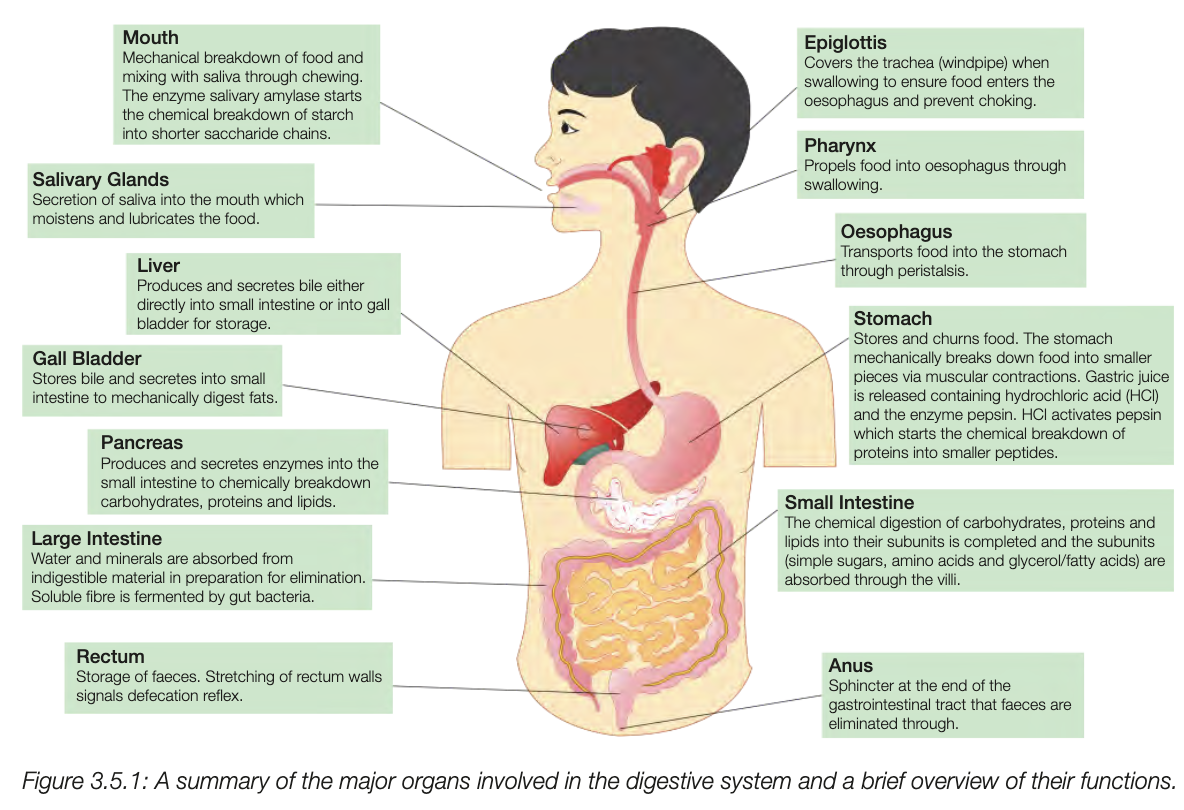
what happens in mouth(perstalsis define as well)
ingested - digestiion begins
food mechanically broken down by teech (mastication) - mixes food with saliva from salivary glands
lubricates food, increases SA for salivary amylase to cehm digest complex carb starch into polysacharides and maltose
swalled thru pharyx to oesophagus, epglottis extends and covers widnpipe to stop chocking
peristalsis (wave of sequential smooth muscle contractions) pushes food down oesphagus
absorption and small intestine
small intestine - hollow tubelike, smooth muscle and perstalsis that propels food through small intestine, duodenum, jejenum, ileum
inner lining covered with villi that absrob digested nutreints
increase SA of small intestine
most occurs at jejenum
single latered epitehlial lining reduces distance for nutrients, is moist
simple sugars and amino acids absorbed across epithelial lining to blood capillaries of villi, fatty acids and glycerol absrobed into lacteal
lacteal
lymph capillary pary of lymphatic system
simple sugars and amino acids absorbed across epithelial lining to blood capillaries of villi, fatty acids and glycerol absrobed into lacteal
nutreints are prcessed by liver, avaialbel for budy to use
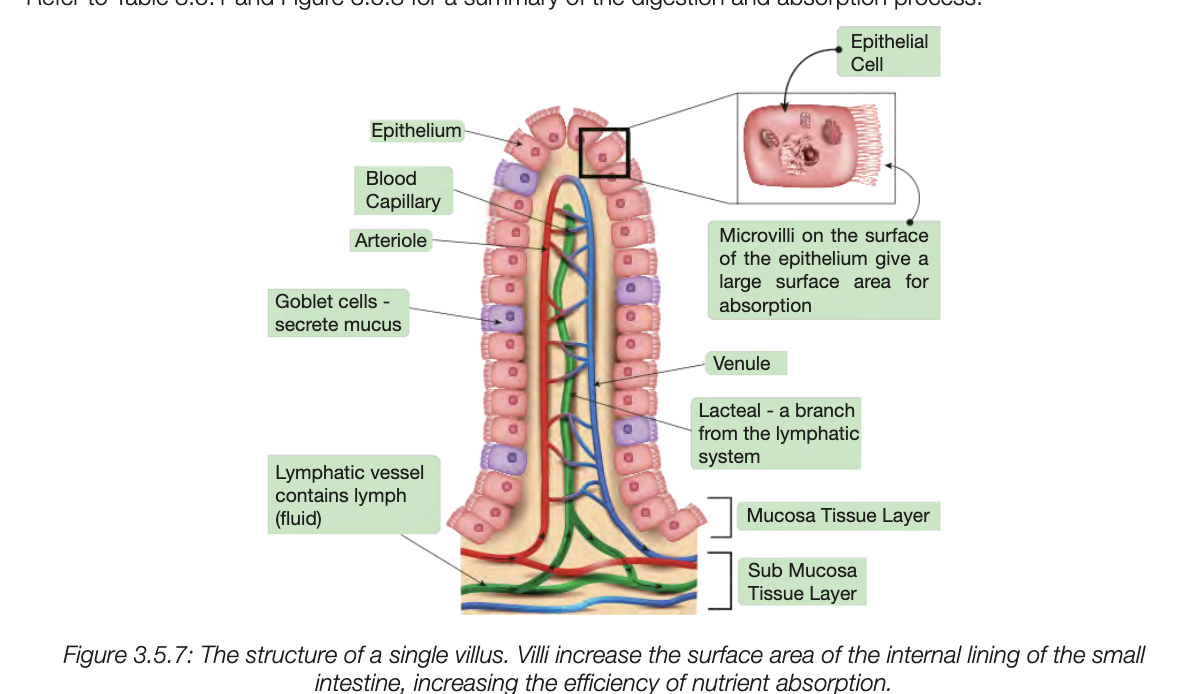
macromolecule, site of chem digestion, products, how transported
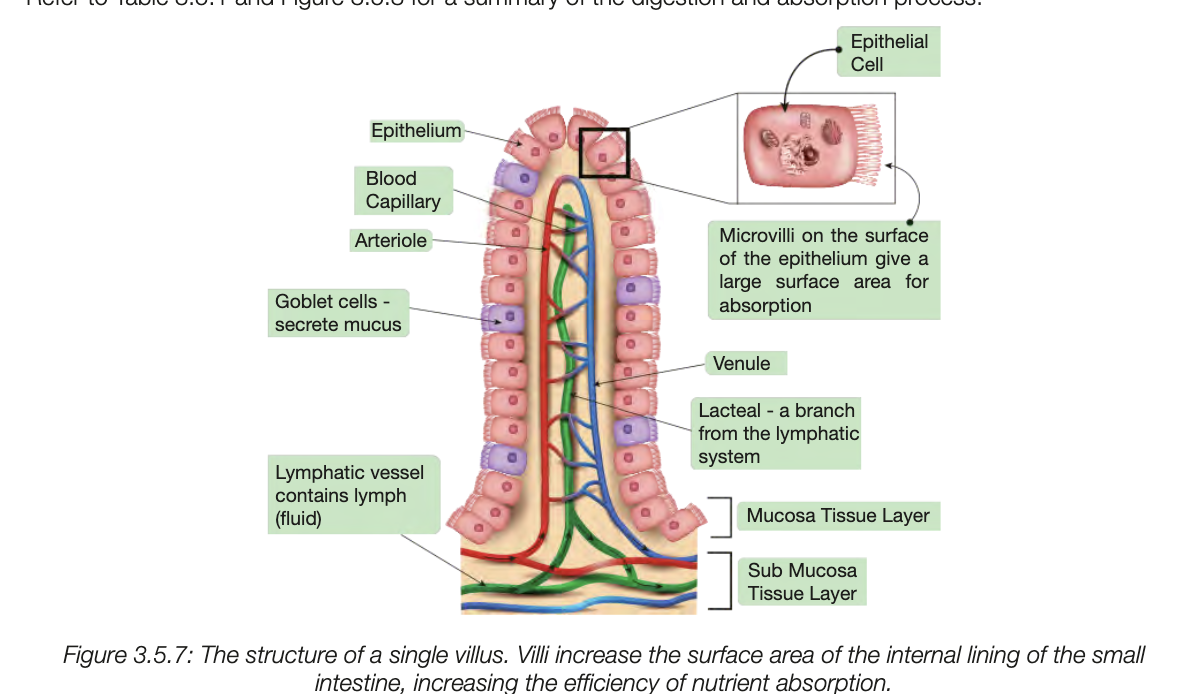
chem digestion of carbs, proteins, fats (image)
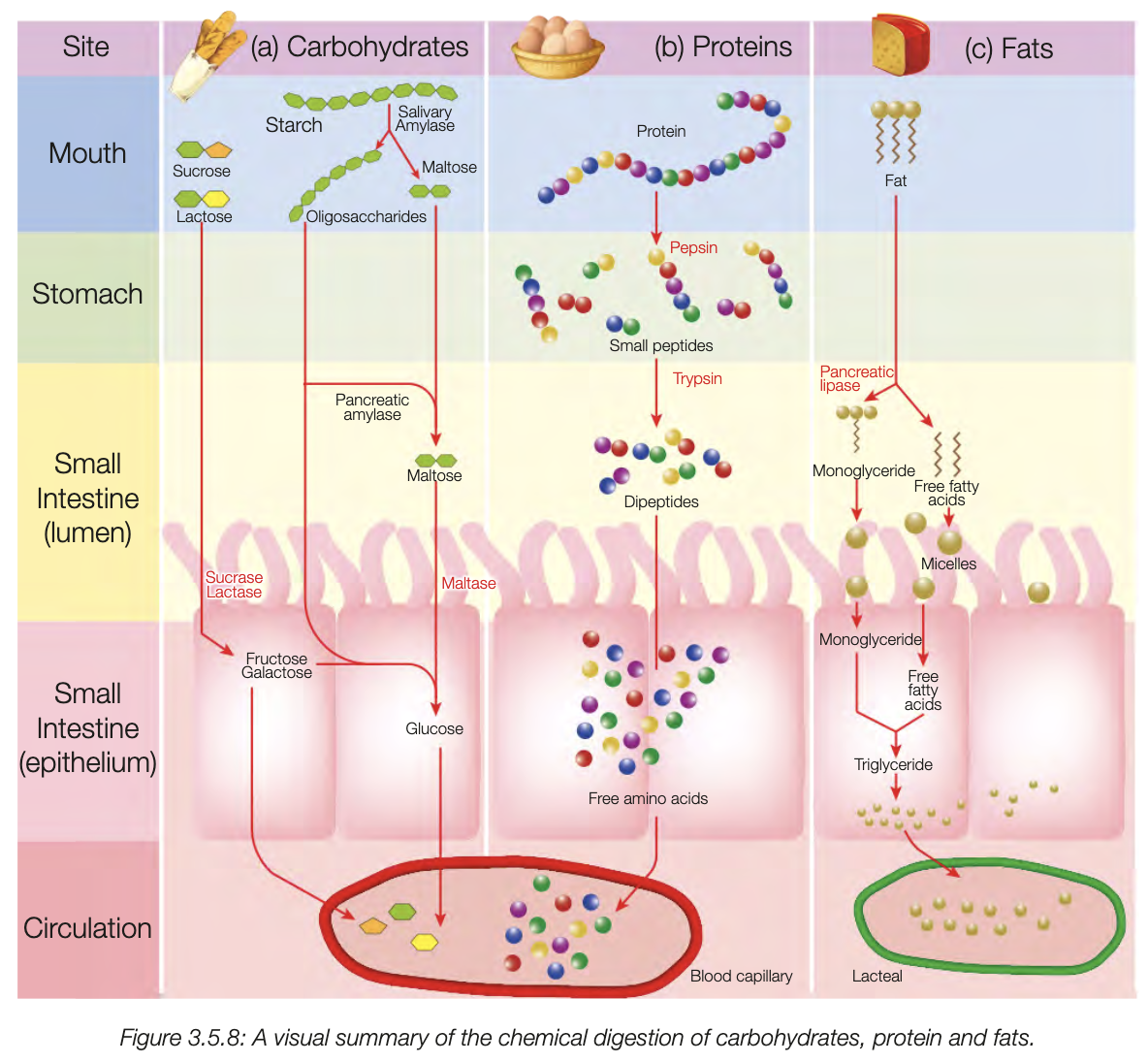
colon and egestion
undigested materials (distery fibre, water, dissolved salts, older cells) reach colon
absrobs water and dssolved salts, trasports stool through peristaltic movements into rectum to prepare for elimination
intestinal bacteria ferments dietary fibre in large intestine and prodcues short chain fatty acids, vitamin k, water, gasses
people cant digest fibre bc they dont have necessary enxymes
indigestale stuff is faeces - stored in rectum exprelled via anus
nephron and structure
structural and functional unit of kidney
over a million in each, large SA for filtration and selective reabsorption
has bowmans capsule, glomerulus, renal rubule
glomerulu - cluster of capillaries located in bowmans capsule
renal tubule 3 parts - proximal, loop of henle, distal
end of tubule joins to collectivng duct, connected to ureter

filtratoin
blood transported from renal artery w high pressure to glomeruls, filered here
high blood pressure causes wataer and small substances to pass thru capillary walls, enters blwmans capsule
larger components arent filtered
liquid passing to bc is glomerular giltrate
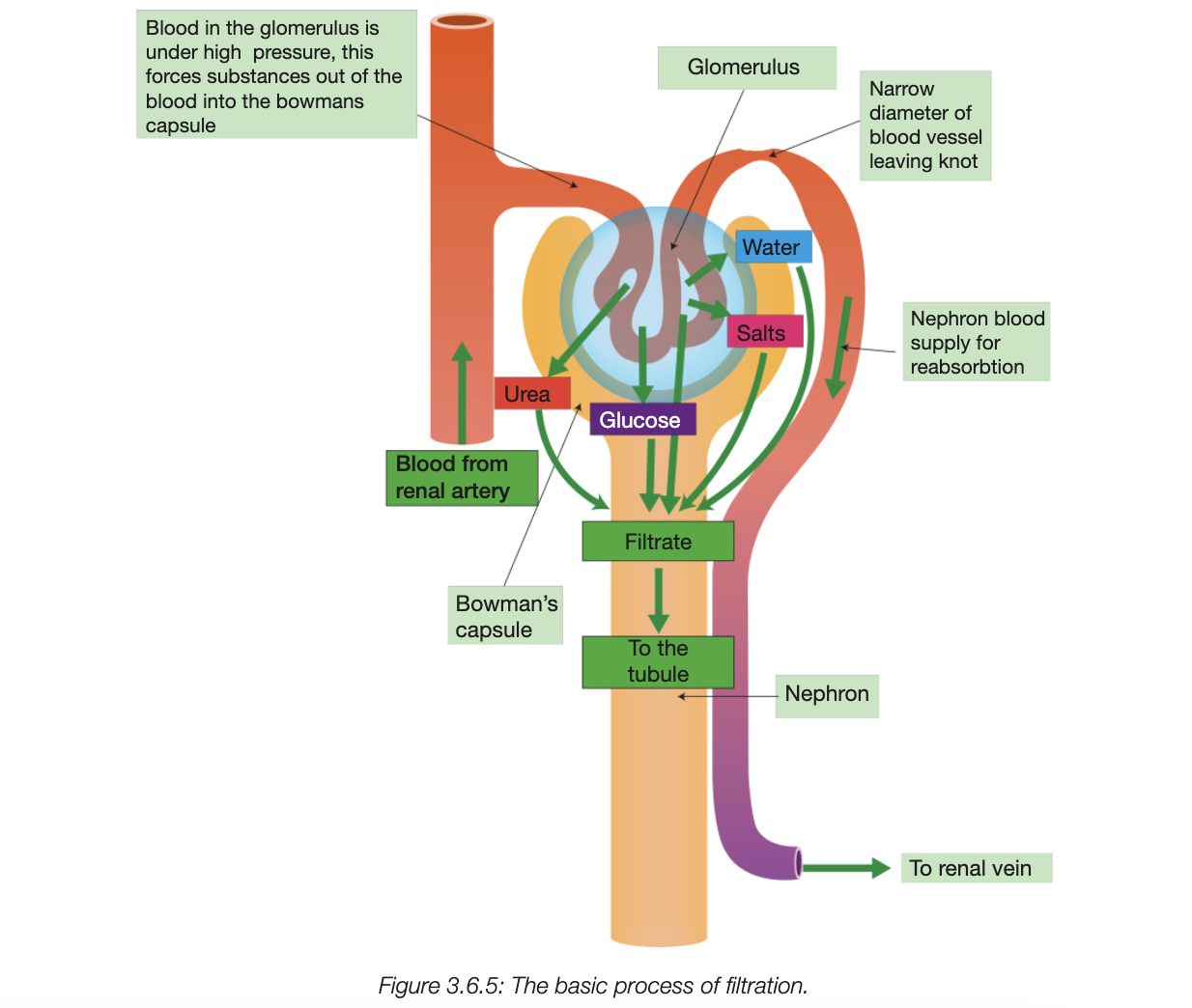
selective reabsorption
filtrate in bowmans capsule flows into tubule, useful stuff are reabsorbed, occurs across length of tubule and some are thru collecting duc (e.g. water)
Proximal tubule: 100% of glucose and amino acids reabsorbed; large amount of water and salts also reabsorbed.
Water reabsorption: About 99% of filtered water reabsorbed by osmosis across tubule and collecting duct (varies with diet, medications, environment).
Salt reabsorption: Amount reabsorbed varies depending on individual factors.
Urea reabsorption: ~50% reabsorbed passively along tubule; collecting duct can reabsorb more if needed.
Urine contents: Remaining urea, nitrogenous wastes, excess water, and other unabsorbed substances exit via collecting duct → bladder.
Blood return: Reabsorbed substances returned to circulation via renal vein → heart.
![<ul><li><p>filtrate in bowmans capsule flows into tubule, useful stuff are reabsorbed, occurs across length of tubule and some are thru collecting duc (e.g. water)</p></li><li><p><strong>Proximal tubule</strong>: 100% of glucose and amino acids reabsorbed; large amount of water and salts also reabsorbed.</p></li><li><p class="my-2 [&+p]:mt-4 [&_strong:has(+br)]:inline-block [&_strong:has(+br)]:pb-2"><strong>Water reabsorption</strong>: About 99% of filtered water reabsorbed by osmosis across tubule and collecting duct (varies with diet, medications, environment).</p></li><li><p class="my-2 [&+p]:mt-4 [&_strong:has(+br)]:inline-block [&_strong:has(+br)]:pb-2"><strong>Salt reabsorption</strong>: Amount reabsorbed varies depending on individual factors.</p></li><li><p class="my-2 [&+p]:mt-4 [&_strong:has(+br)]:inline-block [&_strong:has(+br)]:pb-2"><strong>Urea reabsorption</strong>: ~50% reabsorbed passively along tubule; collecting duct can reabsorb more if needed.</p></li><li><p class="my-2 [&+p]:mt-4 [&_strong:has(+br)]:inline-block [&_strong:has(+br)]:pb-2"><strong>Urine contents</strong>: Remaining urea, nitrogenous wastes, excess water, and other unabsorbed substances exit via collecting duct → bladder.</p></li><li><p class="my-2 [&+p]:mt-4 [&_strong:has(+br)]:inline-block [&_strong:has(+br)]:pb-2"><strong>Blood return</strong>: Reabsorbed substances returned to circulation via renal vein → heart.</p></li></ul><p></p>](https://knowt-user-attachments.s3.amazonaws.com/035d9763-af85-4739-a933-2d37d67f8b71.png)
explain selective reabsorption for the nephron diagram
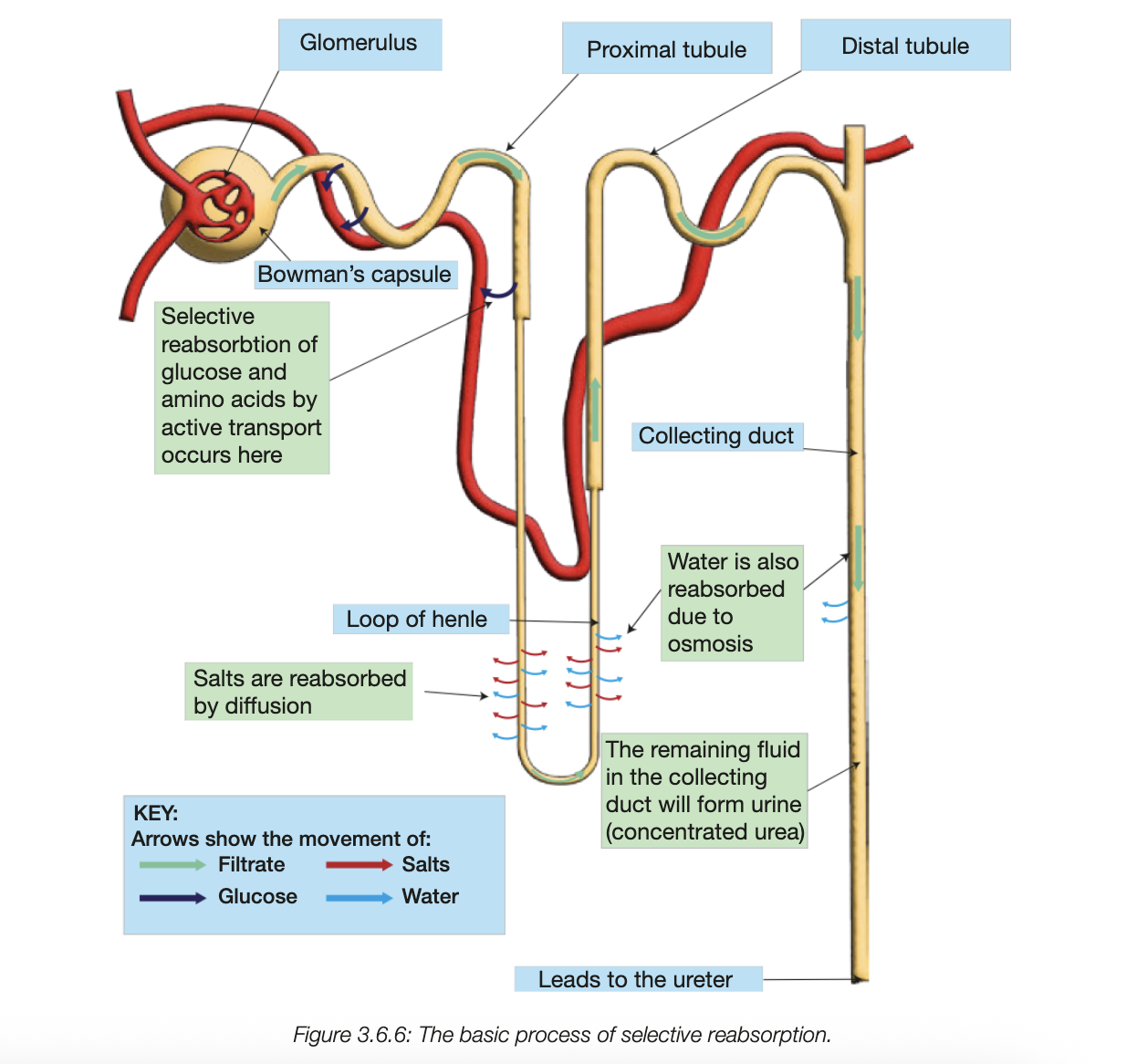
structure and function of parts of nephron
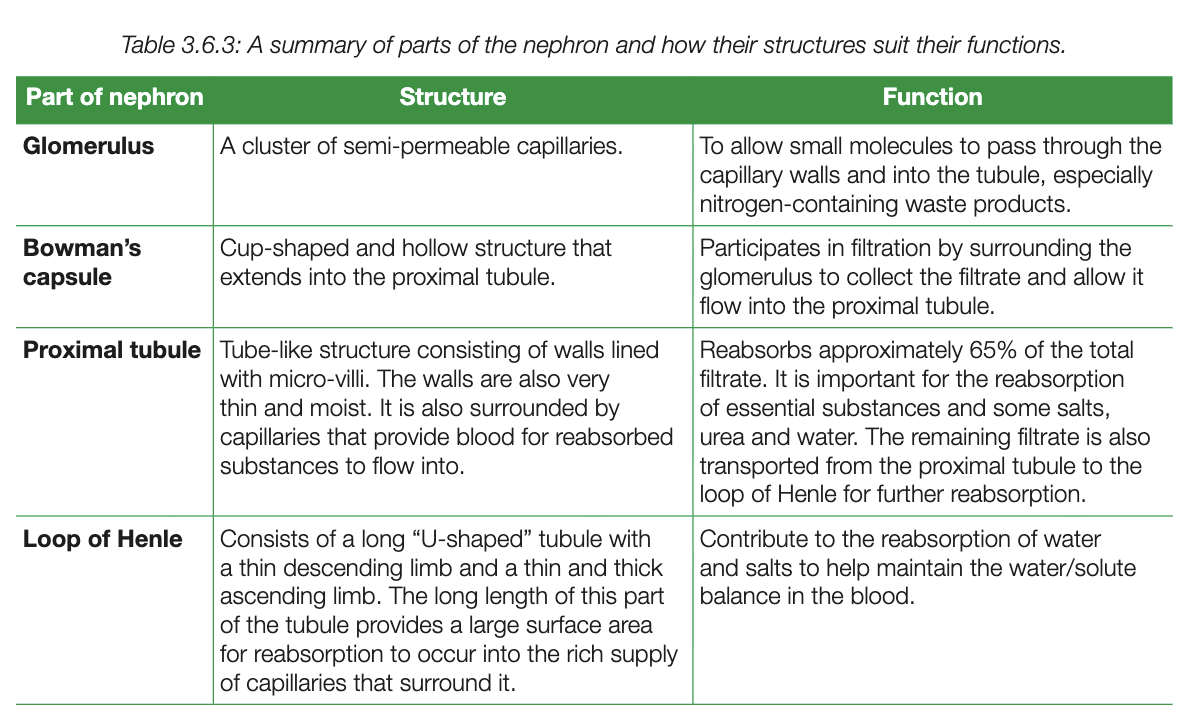
guard cell - plant tissue sstem, image, and description of structure and function
dermal tissue system
pair of bean-shaped cellsm surround stoma
open and close to allow diffusion of gasses
thick cell walls facing stoma, thin facing adjacent epiderman cells
open when gain water and become turgid
thin outer walls bend more easy, causing themt o curve and open stoma
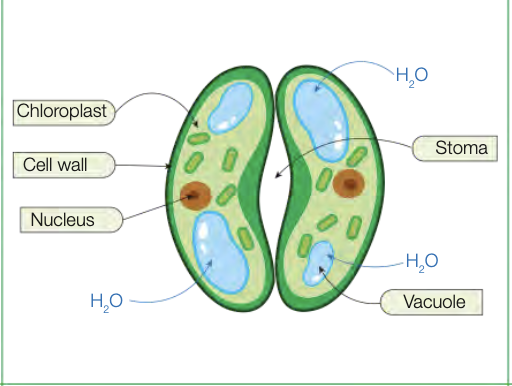
root hair cells - plant tissue sstem, image, and description of structure and function
dermal tissue system
single-celled extensions of epiderman cells in root
increase SA of cells
increase SA increases efficinecy at absorbing water and mineral salts form soil- plant tissue sstem, image, and description of structure and function
xylem - plant tissue sstem, image, and description of structure and function
vascular tissue system
very long hollow tubes consisting of dead cells
arranged end to end, have no cell walls between cells, form continouos tube that water can move through
tough walls, contian woody material (ligning) that thickens vessels
thick walls are impermeable to water so cant leak
lignin deposited in spiral-shape to allow it to remain flexible
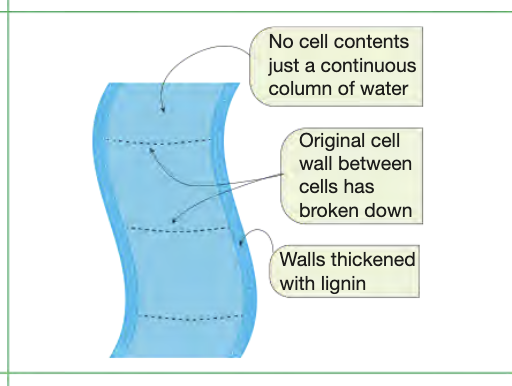
palisade mesophyll - plant tissue system, image, and description of structure and function
ground tissue system
reside directly under upper epidermis, stakcer vertically to max space and fit more in
receive most light, contain most cholorplast to max absorption of light and of photosynthesis
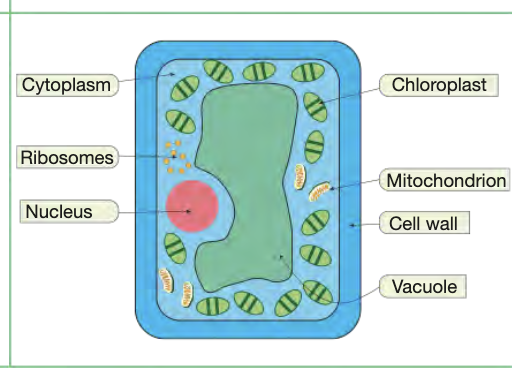
structure and function of leaf
attatched to the stem by a petiole, continues into most ribs to form mid rib
The surface is called lamina
2 main functions - gas exchange and photosynthesis
broad, flat lamina, increases SA
thin to increase the efficinety of gas exchange
stomata facillitate gas exchange
cells have cholroplasts for photosynthesis
spiralling arrangement of leaves ensures each leaf is exposed to sunlight

waxy cuticle, upper epidermis, lamina, palsiade mesophyll, spongy mesophyl, vascular bundles, lower epidermis descriptions and functions
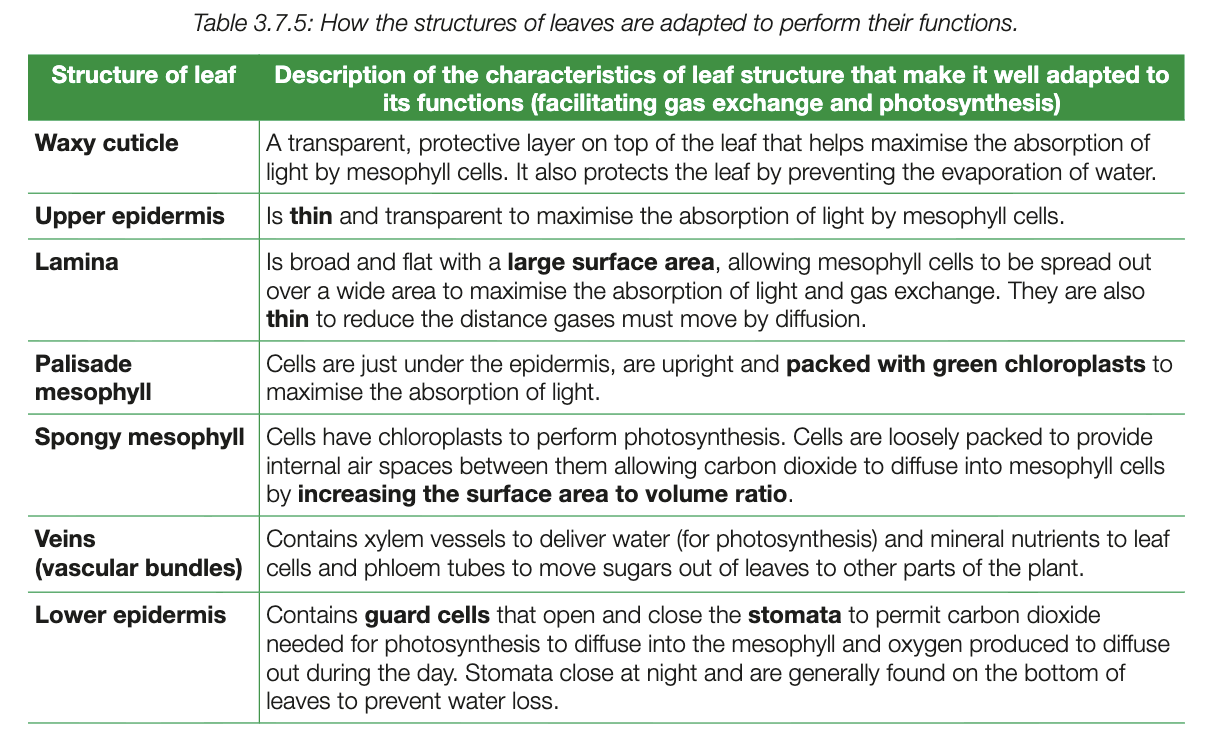
xylem
extend from roots, through to stem, up and through leaves
unidirectional passive transport of water and mineral nutrients from roots to other plant parts
transpiration stream - continuous upward flow of water in xylem vessels
long, hollow tubes, fused dead cells with no contents
arranged end to end, no cell walls bteween (continous tube water can flow thru)
tough walls made of liging - thickens vessels, helps withstand pressure
lignin deposited in spiral shape to allow flexibility
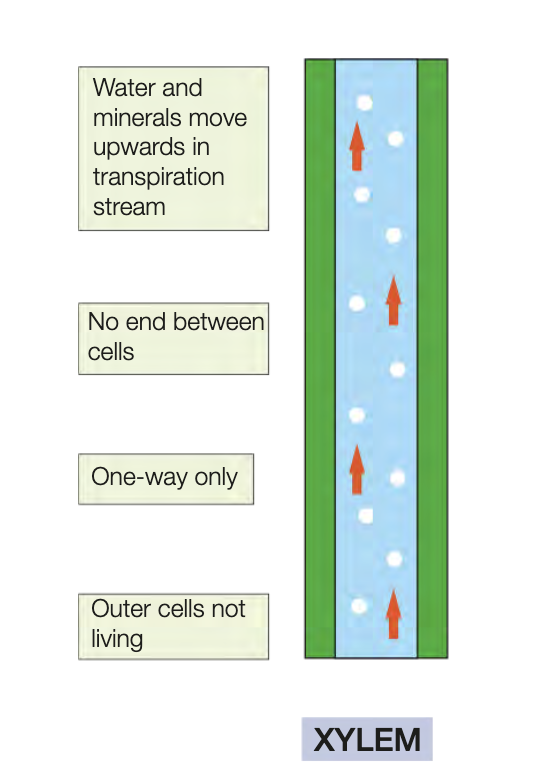
phloem
transport organic molecules (sucrose, amino acids) synthesised by plant
transported to growing parts of plant and to storage organs (e.g. tubers) through translocation
flow of molecules in phloem is bidirectional (up and down tubes)
consist of living cells, don’t have nuclei, contain porous sieve plates at either end so cytoplasm is connected and molecules can move thru them
transport requires energy - sieve tube attached to one or more companion cells that provide the energy
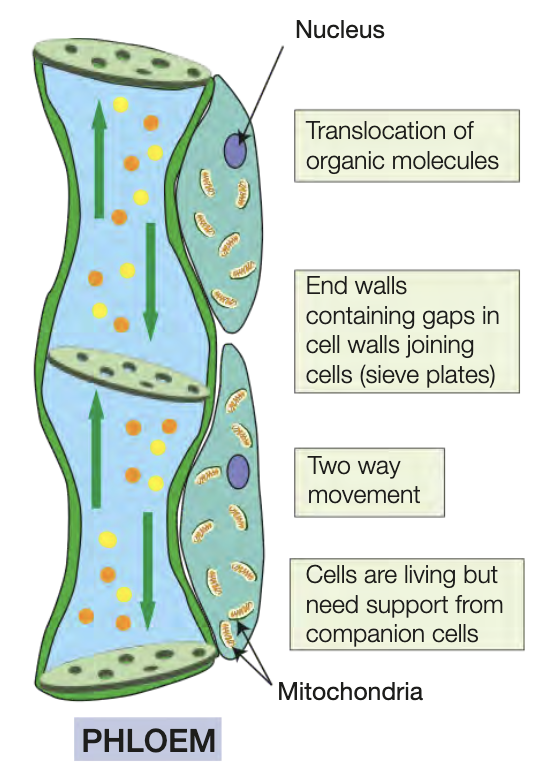
define interspecific and intraspecific interactions and name three type of interspecific interactions
intraspecific - interactions between same speices
interspecific - interactions between different species
types:
competition
predation
symbiosis
competition
ompete for same resources (e.g. light, oxygen, nutrients, prey, space, sexual partners)
no 2 species have identical requirements - overlap is where there is competition
outcome generally has negative effects on weaker competitors
more intense amongst members of smae species
outcompeted species must adapt to remaining available resources or become extinct
significant drive of natural selection and evolution

predation
one organism (predator kills and consumes another or parts of it (prey)
generally occurs between different species, when same sepcies it is cannibalism
cannibalism helps species survive times of limited resources
affects no. of organisms in population, biodiversity of community, evolution of organisms involved
herbivory
consumption of all or part of photosyntehtic organism, generally plant, by animal
can result in death of photosyntehtic organisms but nto always
photosynthetic organisms are producers in most food chains
herbivores and plants drive adaptations in both species
herbivores - digest and extract nutrients from plant matter plants - physical and chem defences
symbiosis
distinct relationships between organisms of 2 diff species
3 types - mutualism, commensalism, parasitism
mutualism
both species benefit
e.g. on image

commensalism
one species benefits, other in unaffected
e.g. on image

parasitism
one benefits, other is harmed
invovles organisms called parasite harming organism called host
e.g. on image

autotrophs (and producer define)
convert inorganic maetrials into organic molecules needed to sustain life
carry out photosynthesis - light energy convereted to chemical energy
some do chemosynthesis (organic compounds from chemicals)
producers - organisms that carry out autrtophic nutrition
heterotrophs
organimss that feed on other organisms to obtain organic molecules
invovles eating organimc material of other organisms and digesting it
if only feed on producers - herbivore
if only feed on other animals - carnivore
omnivore - both
decomposers
heterotrophs that extract energy from remains/waste products of organisms from all trophic levels - break down dead matter and recycle nutrients - wihtout, dead organisms and matter build up
food chains and food webs
show feeding relationships
arrows point in direction energy and nutrients mvoe
many consumers represented at several trophic levels, therefore food web is more realistic representation
decomposers breakdown at every level
trophic levels, consumers
trophic level - relative position of an organism in the food chains
1st - producer, synthesises own energy-rich compounds (e.g. plants)
remaining - heterotrophs, feed on producers and other animals consuming producers, consumers
first consumer in fodo chain - primary consumer - 2nd trophic level
seconadry consumer - eats primary consumer, 3rd trophic level
consumer at top of food chain - apex predator, no natural predators
food web - many linked fodo chains, more accurate
biodiversity (+define genetic, species, and ecosystem diversity - answer on image)
variety of living things on earth
generally expressed at 3 different levels - genetic, species, and ecosysten diversity

importance of biodiversity
maintain contunity of life on earth
privision of o2, food, water
provision of resources and raw materials
source of organic moelceus for medicinal purposes
breakdown of waste materials
provision of natural sites for recreation and appreciation of nature
dichtomous key
presents a series of mutually exclusive choices, one applies to a species, lead on until the correct statement leads to the identification of the species
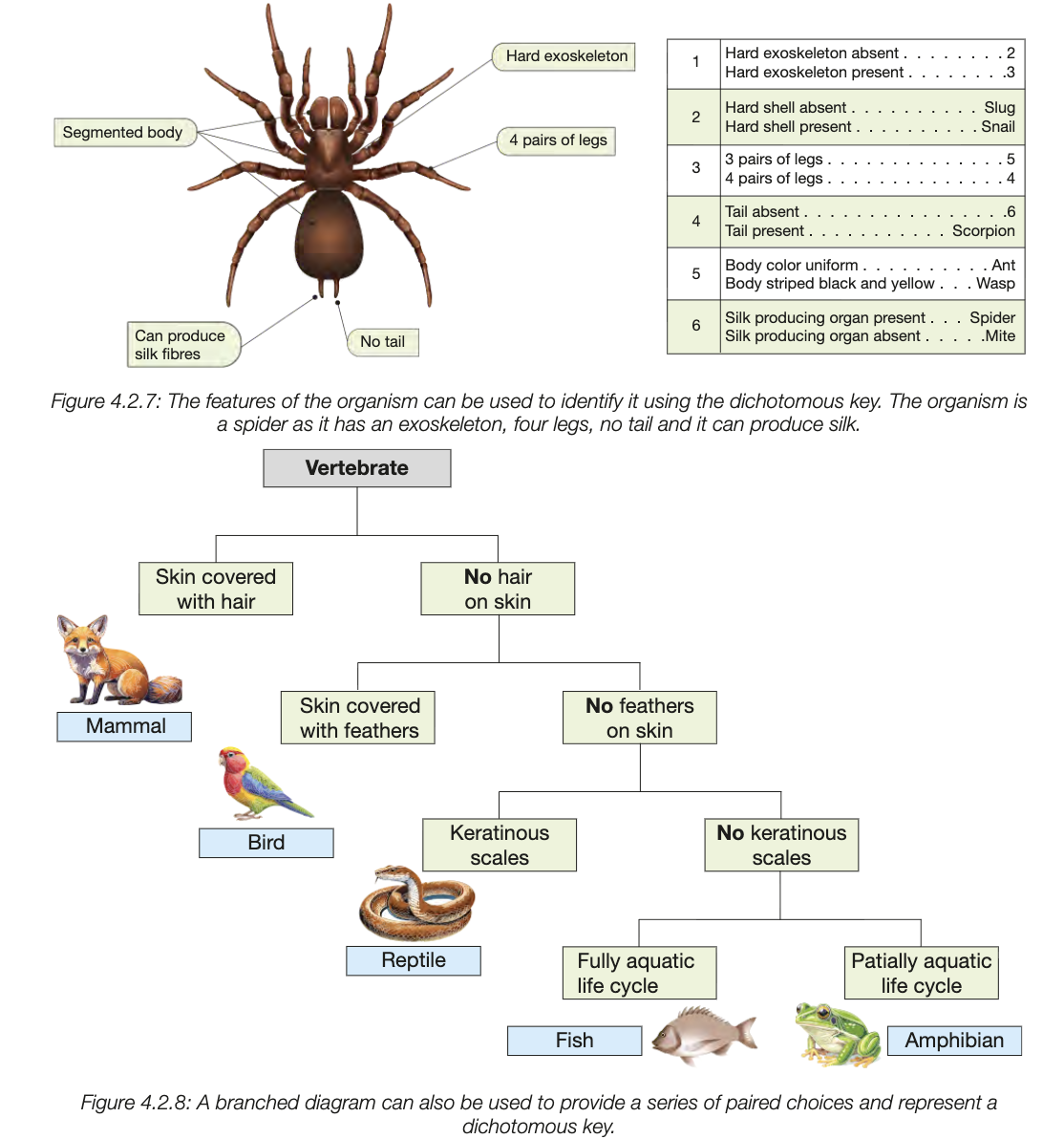
reproductive isolation (possibly add more to this)
seperate species cannot interbreed and preduce fertile offspring - species are reprodcutively isoalted from other ones
attraction of mates - pheramone chemicals released by one of the sexes - only attract members of their own species
reproductive barriers foring isolating boudnaries around closely reltaed speices can be divided into two groups - prezygotic and postzygotic isolating mechanisms
pre-zygotic and post-zygotic mechanisms
PRE ZYGOTIC
any mechanism occuring before gametes fuse to make zygote
e.g. diff matinc calls and rituals, specific pheramones, difference in flower shape/genitalia, different seasons/times for reproduction, inability of sperm to survive female reproductive system
pollen tubes unable to grow in ovules in a flower
Post Zygotic
any mechanism after gametes fuse to form a zygote
e.g. zygote fails to develop (miscarraige), young fails to reach sexual maturity, offspring live but are infertile